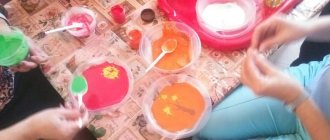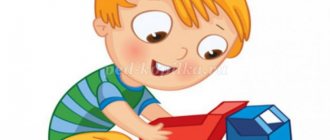Business game for teachers “Adaptation to kindergarten”
Bibliographic description:
Zharkova, Yu. N. Business game for teachers “Adaptation to kindergarten” / Yu. N. Zharkova. — Text: direct // Questions of preschool pedagogy. — 2021. — No. 5 (15). — P. 47-51. — URL: https://moluch.ru/th/1/archive/100/3604/ (access date: 12/19/2021).
Goal: to update teachers’ theoretical knowledge about the process of child adaptation to kindergarten, to expand the repertoire of pedagogical techniques and play interactions with adapting children.
Introductory part . Creating a positive attitude at work.
Warm-up game.
Little eyes, little eyes, are you awake? (we stroke the eyelids with our fingertips)
Woke up! (look through hand-held binoculars)
Ears, ears, are you awake? (we stroke our ears)
Woke up! (gently tugged at their ears)
Hands, hands, are you awake? (we stroke our palms on both sides)
Woke up! (clap our hands)
Legs, legs, are you awake? (we stroke our legs)
Woke up! (stomp our feet)
Exercise “Me today”
Dear Colleagues! We all have easy, fun days, but it also happens that the day is not going well, there are problems at home, difficulties at work. Therefore, it is so important to be able to support yourself and please, because ultimately each of us is responsible for our own good mood and positive perception of life. I offer you a game in which everyone should praise themselves, say something good about themselves, starting with the words “today I...”. Each teacher winds the end of the thread from the ball onto his finger, saying “today I am... (so beautiful, cheerful, skillful, active... etc.). In the end, all teachers find themselves united by one thread. We have a common goal, we are all alike and each of us is good and wonderful.
Main part. The participants of the game are divided into teams.
Task one. Each team draws a symbol (picture) on a piece of Whatman paper that characterizes the concept of “adaptation” and gives it a definition.
Task two. Entering kindergarten is a stressful situation for any child. There are adaptation (neurotic) reactions that can be considered natural during this period. Let's remember them by completing the following task. Each group receives several cards on which one or another behavior of the child is described. A group representative reads out a description of the behavior and explains whether the behavior is a normal adaptive response or not.
Situation 1. Nastya recently went to kindergarten. The girl has become more capricious and cries often.
Situation 2. Ilyusha has been going to kindergarten for 3 weeks. A previously active child in a group behaves quietly and expresses little emotion.
Situation 3. Alice has been attending kindergarten for 1.5 months. At night I began to wake up frequently and say that I had a dream about something terrible.
Situation 4. Oleg is attending preschool for the second year. Since the boy started going to kindergarten, it has become very difficult to put him to sleep. Before going to bed, he spins for a long time, worries, cries, asks to go to the toilet, drink, sit with him. This may last an hour or more.
Situation 5. Olya has been attending kindergarten for 4 weeks. She eats almost nothing in the garden, but at home she pounces on food.
Situation 6. Kostya goes to kindergarten. He refuses to eat rectangular cottage cheese casserole; at home he eats only round cheesecakes.
Situation 7. Lena went to kindergarten in September, and by November she had already had colds 4 times. It's like a week, a week on sick leave.
Situation 8. Misha is 3 years old. He spoke well, but when he went to kindergarten, after some time, he practically stopped speaking and communicating.
Situation 9. Vera is 2 years old. She started speaking in sentences a couple of weeks before kindergarten, but the sentences disappeared when she started preschool. The girl has been going to kindergarten for 2 weeks and speaks only a few words.
Situation 10. Vita is 3 years 7 months old. He has been going to kindergarten for 3 weeks, has become angry and stubborn, shouts “no” for any reason, does everything the opposite.
Situation 11. Arina started using the potty before she was 2 years old, but when she went to kindergarten, her panties often got wet.
Situation 12. Petya has been going to kindergarten for more than a year. He stopped eating in kindergarten, and if he is persuaded to eat a couple of spoons of porridge or soup, he almost immediately vomits the food he has eaten.
After analyzing the examples, the presenter summarizes what problems may arise during the child’s adaptation to kindergarten:
– emotional disturbances (moody, tearfulness, or vice versa, the child becomes quiet and unemotional);
– behavioral disturbances, manifestations of the crisis return or intensify for 3 years;
– problems with sleep (symptoms depend on the child’s nervous system - shallow sleep, difficulty falling asleep or waking up);
– problems with appetite;
– decreased immunity and frequent colds;
– decrease in speech function if it is in the stage of formation; for children with developed speech and confident command of it at the age level, such problems will not arise or they will be minimal;
– neurotic manifestations: enuresis, psychogenic constipation and vomiting, pathological habitual actions (finger sucking, nail biting (onychophagia), masturbation, hair pulling (trichotillomania), yactation - rhythmic swaying of the body).
Task three . The problems that we talked about in the previous task can manifest themselves to one degree or another in every child, but the adaptation period may proceed differently for different children. What does this depend on? Team responses.
- Health status. A healthy, physically developed baby has better capabilities of the system of adaptation mechanisms; he copes with difficulties more easily.
– Age of the child. Adaptation is difficult for a two-year-old child, because at 2 years old there is still no interest in peers and the attachment to the mother is too strong; two-year-old children are not very aware of their feelings, cannot talk about them, and cry more. At 3 years of age, adaptation is easier, but is complicated by the crisis of 3 years of age. 4 years is the optimal period: the child’s speech is mature enough to express his desires, the child is more stable and balanced, this is a period of active assimilation of rules, especially social rules related to correct behavior, the baby is drawn to peers, wants to communicate and make friends. At 5 years old, it is more difficult for a child to join an already established children’s “team”.
– Features of the child’s nervous system. If a child is initially weakened, immature somatically and psychophysiologically, he will quickly develop a decrease in immunity.
– Features of the communication sphere. Typically, the adaptation process proceeds more smoothly for a child who has skills in situational and business communication. Adaptation occurs most easily in children who can act with toys for a long time, in a variety of ways, and with concentration. When they first enter a preschool institution, they quickly respond to the teacher’s invitation to play and explore new toys with interest. It is easier for a child who knows how to play well to make contact with any adult, since he has the necessary means for this.
– Family upbringing is the most important factor. It is more difficult for a child who is accustomed to being the center of attention and spoiled to adapt. Such children often show correct behavior in kindergarten and “have a blast” at home. Mom's guilt is another significant point. An anxious mother who feels guilty can compensate for the time the child spends in kindergarten not by communicating with him, but by indulging in any whims. If overprotection prevails in the family, then the child, even if he has experience communicating with other children, may not have a model of interaction with peers. In overprotective families, all the child’s communication with other children is usually built by the mother, not allowing the son or daughter to gain experience in interaction and conflict resolution.
– Peculiarities of the child’s psyche. It is difficult for an emotionally labile child to understand his emotional state and his attitude to the situation. There may be high anxiety (without lability): such children withdraw, do not interact, and are prone to somatization (sleep and appetite disorders).
Task four. The teams name the stages (phases) of a child’s adaptation to a preschool institution:
– acute phase. What we call maladjustment;
– adaptation phase (begins to get used to kindergarten, children, separation from mother);
– compensation phase (the emotional and physical state of the child is normalized).
Normally, the adaptation process lasts from 1–2 weeks to 3–4 months.
An adapted child goes to kindergarten with pleasure or goes without pleasure, but accepts the situation.
Task five. In the last task, let's discuss what we, kindergarten teachers, can do to help children get used to new conditions and feel as comfortable as possible. Each team completes a table of activities to facilitate adaptation (see Table 1). Teachers write down why this or that activity is important, and also give examples from practice. At the end of the meeting, each teacher will be able to enrich their collection of games, pedagogical techniques and approaches to working with a child.
Table 1
Measures to facilitate children's adaptation
| Event name | Why is it important | Examples of activities, games, teaching techniques |
| Appearance and behavior of the teacher | ||
| The use of distractions during separation, crying - games that inhibit the negative reactions of children | ||
| Bringing the group space closer to home | ||
| Using skin-to-skin contact | ||
| Social Interaction Games | ||
| Games to mark your boundaries | ||
| Sensory games | ||
| Rhythm games | ||
| Your options |
Examples of games, activities, pedagogical techniques that promote a child’s adaptation to kindergarten.
“The wind walks across the sea” (play with tactile contact relieves tension, introduces children to each other, improves mood).
Children and teacher stand in a circle. Everyone holds a transparent stole or a piece of light fabric together. Raising and lowering their hands (the fabric “flapping” like a sail), children and adults say the following words:
- The wind blows across the sea,
- The wind blows the sail,
- The sail is covering Tanya! (the teacher covers one of the children with a cloth).
- Where is our Tanya? And here she is! (everyone, laughing, pulls the cloth off the child and “finds” Tanya.
Next, another child is selected.
“Sitting and sitting on a pebble” (play with tactile contact relieves tension, increases the child’s sense of importance, and promotes unity in a group of children).
Children and teacher stand in a circle. The driver is chosen - one of the children. He sits in the center and a scarf is thrown over his head or shoulders. Children and adults walk in a circle, singing:
I'm sitting, sitting on a pebble,
I'm on gas.
And who loves me deeply?
And who will regret it?
Who will replace me?
Anyone from the circle strokes the child in the center. The one who stroked sits in the driver's seat. Option - they all “sorry” together, after which the driver chooses who will replace him.
“Guli-gop” (rhythmic game, helps reduce tension, improves children’s mood, distracts from negative experiences).
Children and the teacher sit randomly on the carpet or on chairs.
Guli-guli-guli-gop (clap hands and knees alternately)!
They sat on Mashenka’s forehead (put their palm on their forehead).
Wings clap-clap (depict wing movements).
Guli-guli-guli-gop (clap hands and knees alternately)!
Gradually the pace of the game increases.
Sensory play is especially useful for anxious children and children with neurotic manifestations:
– games with water and sand
- pass in a circle a sounding or vibrating toy, a pine cone, a shell with the “sound of the sea”, jars with smells, a mirror, etc.
– game with a “sunny bunny” (flashlight)
– wind and listen to the music box, and then hide and look for it to wind it again
- take out outfits or their elements (hat, glasses, nose or mustache on a string) from the bag and dress up.
Games that inhibit children's negative reactions:
– monotonous hand movements (stringing pyramid rings or balls with a hole on a cord);
– squeezing the hands (rubber squeak toy);
– drawing with felt-tip pens, paints, markers on paper, easel, board;
– listening to music: quiet, calm and funny, cheerful.
- “Mom, dad, toad, tsap!” Children place their fingers on the open palm of the leader. The presenter says the words: “Mom, dad, toad, tsap!” and on the word “tsap” he squeezes his palm. Players must have time to remove their hands, otherwise they will be caught.
Techniques for bringing the group atmosphere closer to home:
– bring your favorite toy from home;
– place photographs of children and parents in the group;
– cozy sofas and armchairs where you can sit and lie down;
– call the child by an affectionate “home” name.
Final part.
Participants reflect on the experience gained. Everyone is asked to complete the sentences:
I like it….
I did not like…
It was new for me...
I can use it at work...
Next time I would like...
Literature:
- Barkan A.I. The child is doing well in kindergarten. How to achieve this? A book for educators and parents / A. I. Barkan; N.V. Anashina. — Moscow: OlmaMediaGroup/Enlightenment, 2015.
- Vasilkina Yu. K. What to do if the child does not want to go to kindergarten / Yu. K. Vasilkina. - Moscow: Eksmo-Press, 2013.
- Young children in preschool institutions: a book for kindergarten teachers: [methodological manual] / K. L. Pechora, G. V. Pantyukhina, L. G. Golubeva. - Moscow: Education, 1986.
- Zarubina Yu. G. Adaptation of a child in a group and the development of communication during a play session CIRCLE / Yu. G. Zarubina, I. S. Konstantinova, T. A. Bondar. - Moscow: Terevinf, 2009.
Key terms
(automatically generated)
: kindergarten, child, game, situation, preschool, home, child’s nervous system, correct behavior, decreased immunity, tactile contact.




